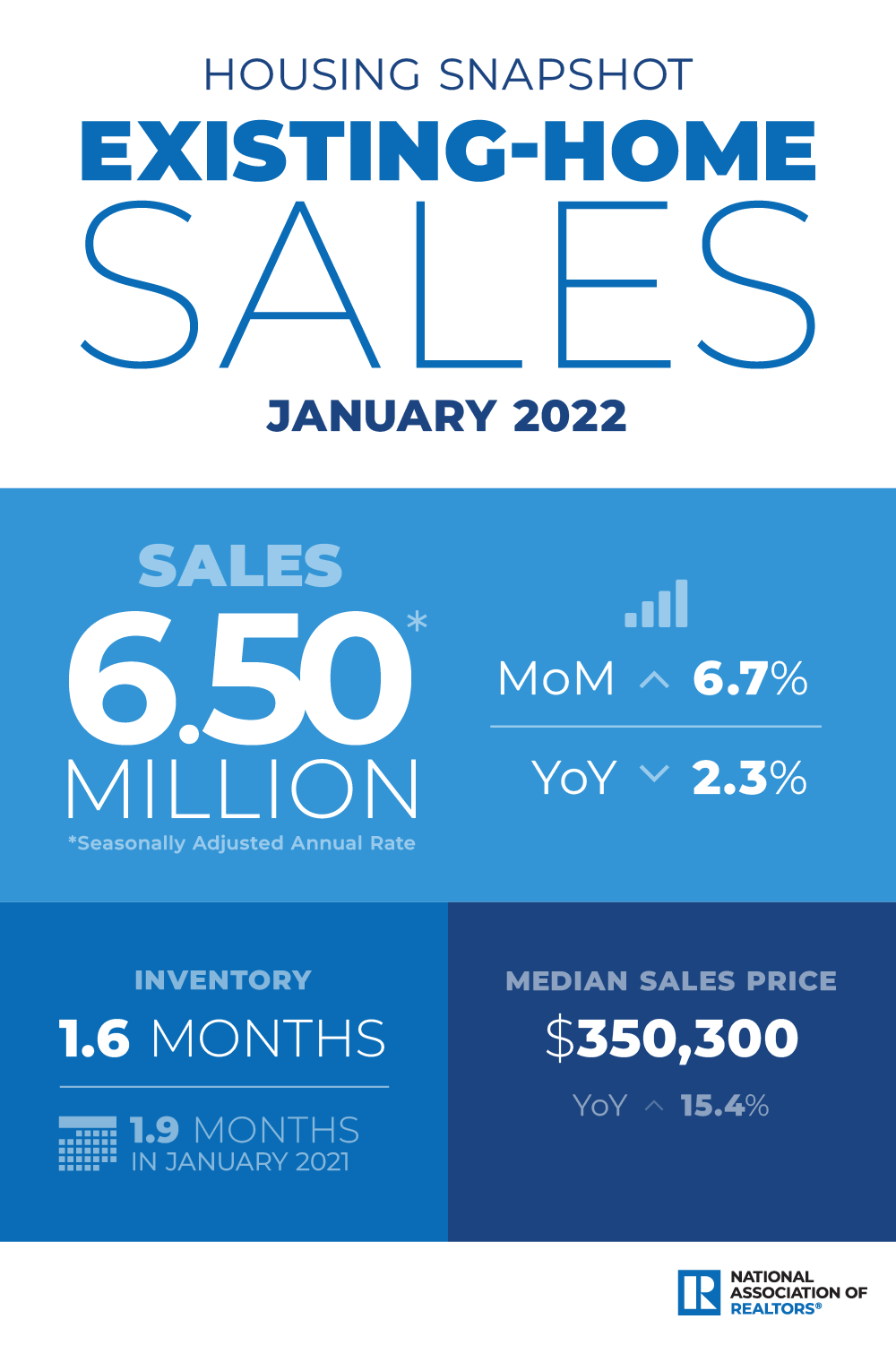The housing market kicked off 2022 on a positive note, as buyers rushed to snag and lock in the best mortgage rates they could, according to a new report from the National Association of REALTORS® (NAR).
NAR’s latest existing-home sales report on Feb. 18 showed that sales of previously-owned homes climbed in January by 6.7% to a seasonally adjusted annual rate of 6.5 million. Each of the four major U.S. regions saw a month-over-month increase in sales activity.
While January marks a significant uptick from the month prior, year-over-year sales fell 2.3%.
Single-family home sales climbed to a seasonally adjusted annual rate of 5.76 million in January, up 6.5% from 5.41 million in December and down 2.4% YoY.
Existing condominium and co-op sales were recorded at a seasonally adjusted annual rate of 740,000 units in January, up 8.8% from 680,000 in December and down 1.3% from one year ago.
Razor-thin housing inventory continues to strain the market, according to NAR economists who indicated that the total supply of homes on the market is currently at an all-time low.
At the end of January, housing stock hit 860,000 units, down 2.3% from December and down 16.5% from one year ago. Unsold inventory sits at a 1.6-month supply at the current sales pace.

Regional Breakdown:
Northeast
Existing-Home Sales: 780,000 (+6.8% MoM; -8.2% YoY)
Median Price: $382,800 (+6.0% YoY)
Midwest
Existing-Home Sales: 1.51 million (+4.1% MoM; -2.6% YoY)
Median Price: $245,900 (+7.8% YoY)
South
Existing-Home Sales: 2.94million (+9.3% MoM; +0.3% YoY)
Median Price: $312,400 (+18.7% YoY)
West
Existing-Home Sales: 1.27 million (+4.1% MoM; -6.6% YoY)
Median Price: $505,800 (+8.8% YoY)
What it Means:
“The market is still thriving as an abundance of home sales took place in January. We will continue to beat the drum for more inventory, which will give buyers additional options and will also help alleviate increasing costs.”— Leslie Rouda Smith, NAR president
“Buyers were likely anticipating further rate increases and locking-in at the low rates, and investors added to overall demand with all-cash offers. Consequently, housing prices continue to move solidly higher.
The inventory of homes on the market remains woefully depleted and, in fact, is currently at an all-time low. There are more listings at the upper end—homes priced above $500,000—compared to a year ago, which should lead to less hurried decisions by some buyers. Clearly, more supply is needed at the lower end of the market in order to achieve a more equitable distribution of housing wealth. — Lawrence Yun, NAR chief economist
“Ongoing cost pressures from rising home prices, which rose 9.1% in January, and mortgage rates, which are fast-approaching 4%, continue to provide home shoppers with strong motivation to search early this year, but limited options pose an ongoing challenge. In fact, NAR data showed inventories were down 16.5% from a year ago in January to a new all-time low.
Housing market momentum will be tested by rising mortgage rates in 2022. The major question is whether rising rates will quench housing demand that stems, in large part, from a demographic tidal wave of young households at key homebuying ages. So far, buyer activity has been resilient to the extra costs of homeownership even in the face of factors that could shift or squeeze housing budget priorities, including a fading pandemic mindset and inflation pressures. Our expectation is that we’ll continue to see home sales at a relatively high level throughout 2022, as post-pandemic shifts like rising workplace flexibility enable would-be buyers to expand their geographic search horizons and find an affordable place to call home.” —Danielle Hale, Realtor.com chief economist
“January saw the strongest pace of existing-home sales in a year, even with mortgage rates jumping 30 basis points over the month and home-price growth continuing at a rapid pace. While the 6.7% sales growth in January was good news, the drop in for-sale inventory to an all-time low at 860,000 units is a cause for concern. There were more listings at the higher end of the market, and the median sales price increased for the third straight month, suggesting fewer entry-level and less expensive options, making home-purchase conditions more difficult for first-time buyers. Their share of sales dropped to 27% compared to 33% a year earlier.
“The increased activity in the higher-priced segments of the market was consistent with MBA data showing that the average loan size on purchase mortgage applications reached record highs in January. There was also added competition from buyers of investment and second-home properties, who accounted for a growing portion of home sales last month.” —Joel Kan, MBA AVP of economic and industry forecasting
 Jordan Grice is RISMedia’s associate online editor. Email him your real estate news to jgrice@rismedia.com.
Jordan Grice is RISMedia’s associate online editor. Email him your real estate news to jgrice@rismedia.com.











